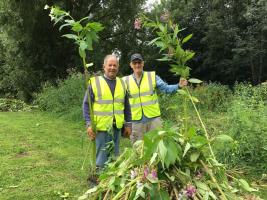Club Meeting Acton Parish Hall
Tue, Sep 14th 2021 at 12:30 pm - 2:00 pm
Gerald Emerton talks about local history of Acton Village.
Desk Rod Stokes, VOT President Tony.
Only 11 members attended the second meeting, which was held at Acton Parish Hall. Rod had rescued the Rotary Bell from the Civic Hall, which saved President Tony from having to tweet again!
Rotary Talk on Acton Village by Gerald Emberton
Can I start by saying thank you for coming to ACTON - it is only a small village – change from third to top and you are through it.
Before the parish hall was built in 1910, Acton consisted of a church, a school, a pub, a smithy, and two farmyards, after the war the RDC built the council houses – they had intended to build twice as many, in a horseshoe – coming out onto the main road at the STAR.
Despite being small Acton has always punched above its weight. In recent times it had a Cottage Hospital, Malbank School, Nantwich Show, and the Local Operatic Society, and a number of other things. It has now lost its pub and both of its farmyards and the hospital.
Acton parish also contains the Basin End, which was the end of the Chester canal and served as the main commercial distribution point for the town and its cotton, cheese and building materials and is now a centre for canal recreation and holidays.
The PARISH HALL was built by the local land owners in1910 the Tollemaches and the Wilbrahams gave the land and helped to build the hall with the intention of providing education and a reading room etc. It was not part of the Church and there is no direct connection.
I was chairman of the trustees from 1980 till 2005 and since then Mike Houlston has been Chairman, it has had rough times and I can remember when the trustees had to have a whip-round to pay for the heating oil, it is now in a much better state and a sound financial footing.
Of course the main feature of ACTON is the CHURCH, there were two priests here at the time of the Domesday Book, which was completed about twenty years after the terrible Norman Conquest in 1066. Most of the land around Acton was laid waste and it was recorded as being the largest place in the Warmundstrou Hundred and consisted of 8 hides when most of the settlements in south and east Cheshire consisted of less than 1 hide. The losing Anglo-Saxon Earl Morcar is believed to have had his base at Hurleston and his deer park at Dorfold, but the new conquering Norman baron Malbank built a castle at Nantwich on an large mound on the Nat West car park, his son Hugh Malbank founded the abbey of Beneditine monks at Combermere about 60 years later in 1133. And was given Acton etc. The abbey became a law unto itself.
In Saxon times Acton was this side of the River Weaver and Wybunbury was at the east side and both had a share of the valuable salt workings at WYCHE. Nantwich as a name is not recorded until about two hundred years later. Domesday only gives Wyche as being for salt tax.
Acton was connected with Combermere Abbey by a straight road through Dorfold, Edleston, Baddington, Sound and Newhall.
The Abbey maintained its grip on the countryside taking a great income including a part of the salt taxes until 1538, when Henry 8th decided he’d had enough of the Roman domination, it was only then that Nantwich was able to expand and become the second most important town in Cheshire after Chester. He sold the abbey lands to people like the Cottons, Vernons and Wilbrahams on the Acton side and a number of families on the Wybunbury side, who were able to concentrate their efforts on improving agriculture.
ACTON got its Anglo-Saxon name,sometime between 650 AD and the Norman Conquest. and in common with other Acton’s was named after a famous oak tree where the local hundred had meetings, this was ‘Warmund’s tree’ (Warmund’s Trou) which later became the Nantwich hundred.
No doubt the monks were responsible for the Church and the base of the tower is claimed to have been constructed from stones taken from a Roman building, although this is not yet been found.
In 1757 a huge gale from Liverpool direction came across Cheshire sinking ships in the Dee and Mersey and breaking the sails off windmills. It also did much damage in Nantwich and blew the tower down at Acton, ruining the Nave etc. It took nearly two hundred years for the church rebuilding to be paid for.
In 1895 the Sutton Timis family, who had made a fortune making soap products in Widnes, commenced an extensive restoration of the church.
President Tony proposed a vote of thanks to Gerald for an interesting insight to the history of the village.
